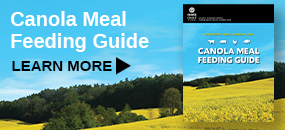

September 2014
Certain protein ingredients have been proven to increase milk protein. But what is the value in increasing milk protein, and what does that have to do with canola meal? Milkpay.com shows that milk protein has the highest component value for producers. For example, increasing milk protein by 0.1 percent of a unit of protein will increase revenue per cow per day by $0.21 for cows producing 65 pounds of milk per day. This means that investments made to improve milk protein yield in areas where payment is based on components (as opposed to just volume) will result in a return on investment if the input costs are less than $0.21 per cow per day.
According to the USDA Economic Research Service, U.S. cheese consumption is increasing rapidly, with annual per capita consumption expected to reach 36.8 pounds by 2022. More cheese production means more milk protein is needed.
Milk protein levels have been carefully studied in the past. Results vary from study to study, due to conditions being slightly different in each trial. To compare all studies, researchers conduct a meta-analysis, which is a statistical tool that allows researchers to combine information from many studies.
There have been two such studies conducted regarding canola meal. The first meta-analysis was conducted at the Agriculture and Agri-Food Canada (AAFC) Research Station in Sherbrooke, Quebec, which compared 49 diets containing canola meal (Martineau, et al., 2013). When cows were fed the same level of protein, researchers found that milk yield was increased by 1.4 pounds per day. Milk protein percent did not increase when the dietary comparisons involved soybean meal, but was 0.05 percent higher when canola meal was fed compared to other protein sources. The resulting greater milk production, and increased protein percentage associated with canola meal when comparing certain diets, translated into 0.6 ounce more protein per cow per day when canola meal was substituted for soybean meal and 1.2 ounces when canola was substituted for other ration protein sources.
Another important meta-analysis was conducted by researchers located in Sweden (Huhtanen, et al., 2011). This study involved 292 dietary comparisons and took a different approach than the other researchers. The Swedish researchers looked at the effects of comparing increased protein in the diet (low protein control), using canola meal or soybean meal. The researchers then looked at which proteins gave a better response. Increasing protein in the diet over all studies resulted in a 4.6-pound milk production per-cow per-day increase with soybean meal. In contrast, the improvement in milk was 7.5 pounds per cow per day with canola meal. Milk protein yield increased by 3.5 ounces with soybean meal and 4.9 ounces with canola meal. This showed that the canola meal protein is used more efficiently to support milk production, as well as milk protein production, compared to soybean meal.
So why should producers be concerned with milk protein levels, and why should they feed canola meal to support milk protein production? Dairy products like cheese, ice cream and Greek yogurt are in higher demand than ever, meaning dairy product manufacturers are willing to pay extra for milk high in protein. Feeding canola meal can help your cows produce high-protein milk, putting more green in your pocket. That’s pretty Canolamazing!


